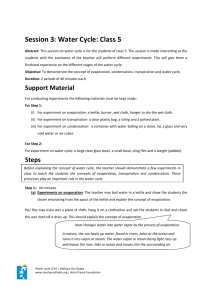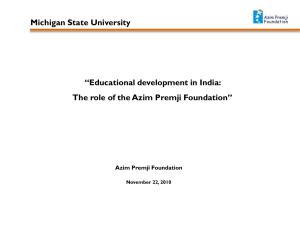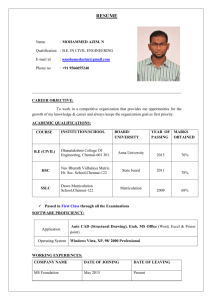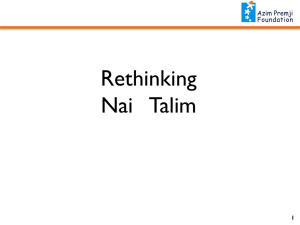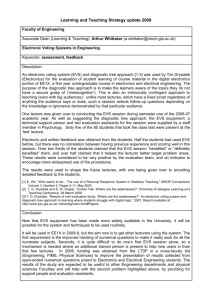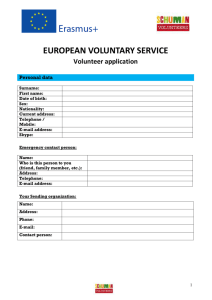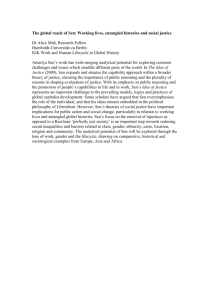Session 2 – Sources Of Water
advertisement
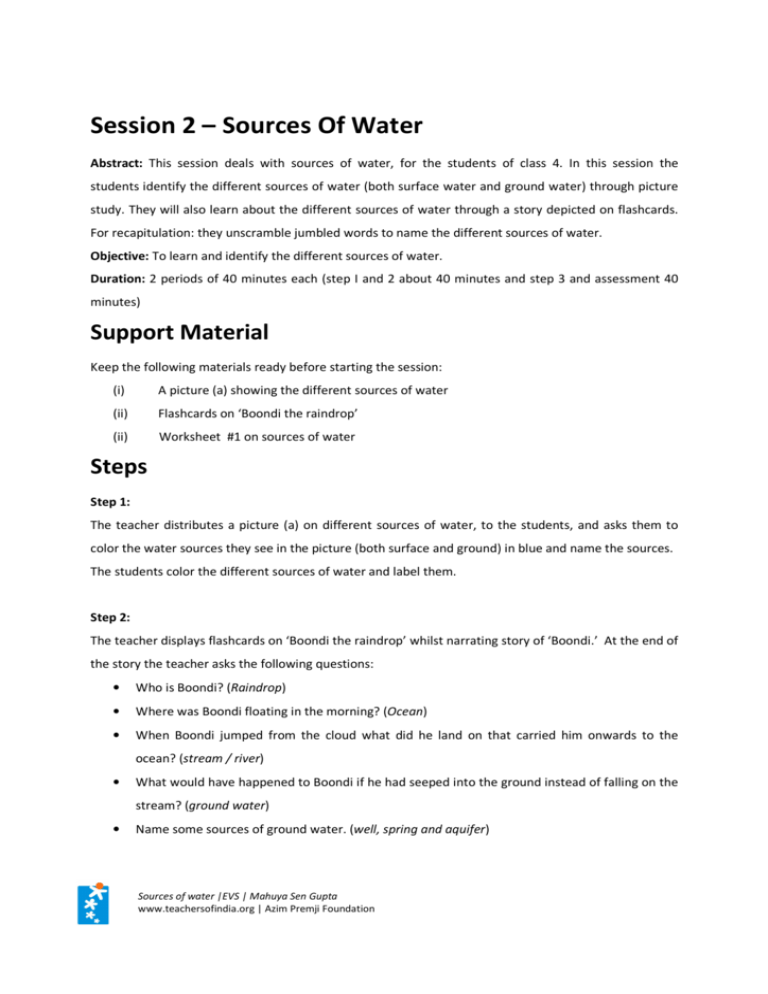
Session 2 – Sources Of Water Abstract: This session deals with sources of water, for the students of class 4. In this session the students identify the different sources of water (both surface water and ground water) through picture study. They will also learn about the different sources of water through a story depicted on flashcards. For recapitulation: they unscramble jumbled words to name the different sources of water. Objective: To learn and identify the different sources of water. Duration: 2 periods of 40 minutes each (step I and 2 about 40 minutes and step 3 and assessment 40 minutes) Support Material Keep the following materials ready before starting the session: (i) A picture (a) showing the different sources of water (ii) Flashcards on ‘Boondi the raindrop’ (ii) Worksheet #1 on sources of water Steps Step 1: The teacher distributes a picture (a) on different sources of water, to the students, and asks them to color the water sources they see in the picture (both surface and ground) in blue and name the sources. The students color the different sources of water and label them. Step 2: The teacher displays flashcards on ‘Boondi the raindrop’ whilst narrating story of ‘Boondi.’ At the end of the story the teacher asks the following questions: • Who is Boondi? (Raindrop) • Where was Boondi floating in the morning? (Ocean) • When Boondi jumped from the cloud what did he land on that carried him onwards to the ocean? (stream / river) • What would have happened to Boondi if he had seeped into the ground instead of falling on the stream? (ground water) • Name some sources of ground water. (well, spring and aquifer) Sources of water |EVS | Mahuya Sen Gupta www.teachersofindia.org | Azim Premji Foundation The teacher collates the answers (of the above questions) on the blackboard and states that these are all important sources of water. She also explains to the class that to obtain ground water, it must be pumped out as in the case of a tube well. Step 3: The teacher also asks the students: How do you get water at home? (tap / water tanker/ pond /stream/ river) If they answer ‘from tap’, the teacher can discuss the following with the students: Water can get dirty, so before we can drink it, it must be clean. Water is cleaned at a Treatment Plant and then sent to our homes through pipe lines to the taps. If the answer is ‘pond’, ‘stream’ or ‘river’, then the teacher needs to discuss how water can be made safe for drinking in the following ways: Boiling, filtering, adding a few drops of chlorine and solar disinfection. Refer teacher’s note (b) Assessment/ Recapitulation 15 minutes The teacher will distribute worksheet (number 1 given in the appendix) on sources of water to the students and discuss the answers with them once they are done. Sources of water |EVS | Mahuya Sen Gupta www.teachersofindia.org | Azim Premji Foundation Support material- 1: Picture – Sources of water Sources of water |EVS | Mahuya Sen Gupta www.teachersofindia.org | Azim Premji Foundation Support material- 2: Flashcards on “Boondi the raindrop’ Sources of water |EVS | Mahuya Sen Gupta www.teachersofindia.org | Azim Premji Foundation Sources of water |EVS | Mahuya Sen Gupta www.teachersofindia.org | Azim Premji Foundation Sources of water |EVS | Mahuya Sen Gupta www.teachersofindia.org | Azim Premji Foundation Sources of water |EVS | Mahuya Sen Gupta www.teachersofindia.org | Azim Premji Foundation Sources of water |EVS | Mahuya Sen Gupta www.teachersofindia.org | Azim Premji Foundation Worksheet: Sources of water Unscramble the following to find the different sources of water: (1) --------------- (NARI) is the most important source of water. (2) Water bodies surrounded by land on all sides are called ------------------ and --------------- (KLASE / DOPNS). (3) The part of the rain water that seeps into the ground forms -------------------- (NEUDROGUDNR TWARE) (4) A small river is called a ----------------- (RESTMA) (5) Several streams join to form a ----------------(VREIR) (6) Most rivers join the --------------- (ASE). (7) ---------------- (RSNPIGS) and ---------------- (LLEWS) are examples of underground water. (8) At home we get water from the --------------- (SPAT) Sources of water |EVS | Mahuya Sen Gupta www.teachersofindia.org | Azim Premji Foundation Teachers’ Resource (a) Sources of water What kinds of water are there? There are two sources of water: • Surface water (water that is found on the top or surface of the earth). • Ground water (water under the earth’s surface) Surface water we see it daily and hence easy to understand. Rain is the most important source of water. After rainfall, some of the water runs off as streams, rivers and ultimately join the sea or ocean. All these sources of water that we see on the surface of the earth are called surface water. The water in the lakes, ponds and reservoirs are surface water too. Water in the sea and ocean are salty and hence unfit for drinking. The rest of the surface water needs to be treated to make it safe for drinking as things like leaves, fish, animal droppings, and boat fuel can easily get into them. Sometimes after rainfall, some of the rain water may seep into the ground and remain stored as underground water or aquifer. Ground water is a little hard to understand than surface water because we cannot actually see this water. The amount of water that seeps into the ground depends on how steep the land is and the nature of the rocks and soils found underground. The steeper the land, the less will be the infiltration or seepage. Hence in such areas, there will be less ground water and more runoff. Again, places that have lots of sand underground will allow more water to sink in than ones that have lots of rock. When the water seeps down, it will reach a layer of ground that already has water in it. That is the saturated zone. The highest point in the saturated zone is called the water table. The water table can raise and lower depending on seasons and the amount of rainfall. Groundwater flows through layers of sand, clay, rock, and gravel. This causes natural filtration and cleans the water. Again as groundwater remains below the surface, things that fall into surface water cannot fall into it. This means that groundwater stays cleaner than water on the surface. Sources of water |EVS | Mahuya Sen Gupta www.teachersofindia.org | Azim Premji Foundation Ground water can get polluted as well. When farmers use fertilizers and insecticides, rain will wash them into the soil where they get into aquifer. Gas stations have big, underground tanks where they keep the gas. If these leak, the gas sinks into the groundwater, too. However, groundwater does not need as much treatment as surface water. This water needs to be pumped out for our use. Wells and springs are good examples of groundwater. (b) Ways to disinfect water (1) Boiling water for 1 minute makes it safe from germs. (2) Filtering water either by cloth or charcoal filter. (3) Adding few drops of chlorine, lime or lemon juice will not make the water completely safe but may be better than no treatment. (4) Solar disinfection: Take a clean glass or plastic bottle. Fill the bottle with water (about ¾ full) and shake it for half a minute. This will add air bubbles to the water which helps to disinfect the water faster. Then fill the bottle to the top and leave in an open space (6 hours in full sun or 2 days if it is cloudy), like the roof of a house. Drink directly from the bottle. Sources of water |EVS | Mahuya Sen Gupta www.teachersofindia.org | Azim Premji Foundation
